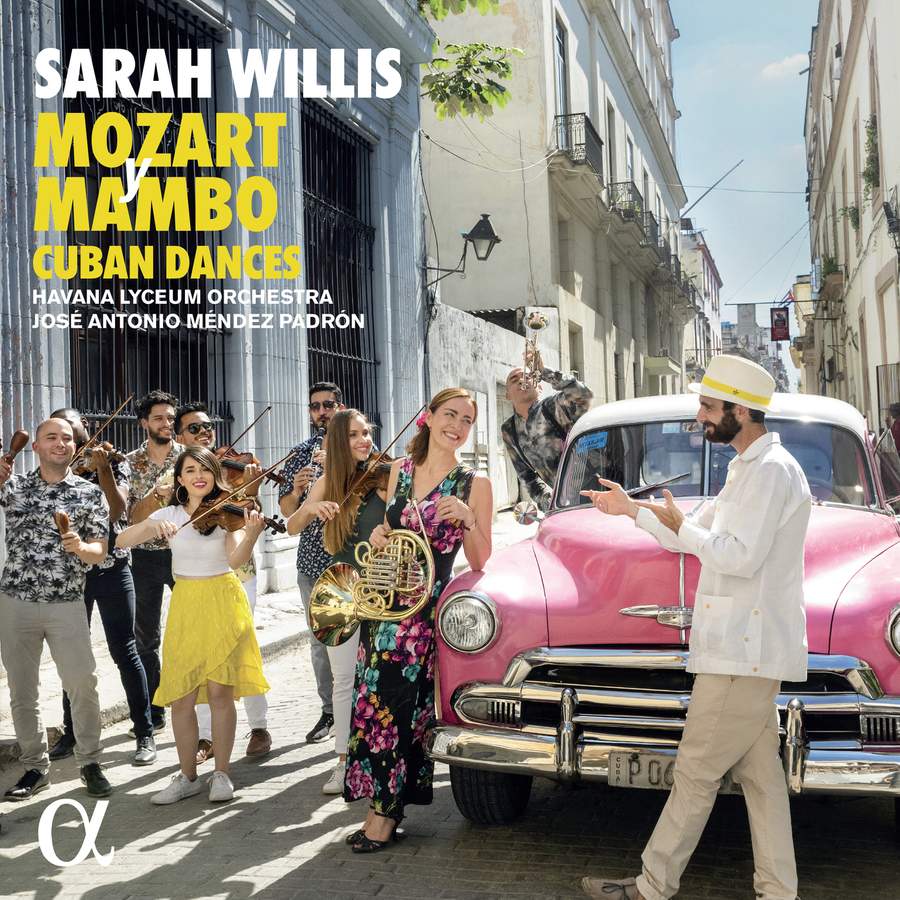Mozart y Mambo: Cuban Dances
View record and artist detailsRecord and Artist Details
Genre:
Orchestral
Label: Alpha
Magazine Review Date: AW22
Media Format: CD or Download
Media Runtime: 61
Mastering:
DDD
Catalogue Number: ALPHA878

Tracks:
| Composition | Artist Credit |
|---|---|
| Veinte Años |
María Teresa Véra, Composer
Havana Lyceum Orchestra José Antonio Méndez Padrón, Conductor Sarah Willis, Horn The Sarahbanda |
| El Bodeguero |
Richard Egúes, Composer
Havana Lyceum Orchestra José Antonio Méndez Padrón, Conductor Sarah Willis, Horn |
| Pa Pa Pa |
Andrea Olivero, Composer
Sarah Willis, Horn The Sarahbanda |
| (4) Concertos for Horn and Orchestra, Movement: No. 2 in E flat, K417 (1783) |
Wolfgang Amadeus Mozart, Composer
Havana Lyceum Orchestra José Antonio Méndez Padrón, Conductor Sarah Willis, Horn |
| Cuban Dances for Solo Horn, Strings and Percussion |
Yasel Muñoz, Composer
Pepe Gavilondo, Composer Enrique Lazaga, Percussion Havana Lyceum Orchestra José Antonio Méndez Padrón, Conductor Sarah Willis, Horn |
| (4) Concertos for Horn and Orchestra, Movement: No. 1 in D, K412/K386b (1791) |
Wolfgang Amadeus Mozart, Composer
Havana Lyceum Orchestra José Antonio Méndez Padrón, Conductor Sarah Willis, Horn |
Author: Andrew Farach-Colton
‘If you can’t dance it, you can’t play it’, writes Sarah Willis in the booklet note for this second instalment of her ‘Mozart y Mambo’ series. And so, the Berlin Philharmonic horn player tells us, she learnt the footwork as well as the notes in order to get to the heart of the six-part suite of dances she’s commissioned (for horn, percussion and strings) from half a dozen young Cuban composers. The result is a marvellous sense of interpretative ease and elegance, even in the most rhythmically complicated dances, such as Pepe Gavilondo and Yasel Muñoz’s Tamarindo Scherz-son, Wilma Alba Cal’s Guaguancó Sencillo and Ernesto Oliva’s ¡Ay Comay! Un Changüí pa’Sari. In the slower, lyrical dances, there are flashbacks to ‘the glittering Havana of the ’40s’, as Willis puts it – and yet the sweet, unabashed sentimentality of, say, Jorge Aragón’s Un bolero para Sarah is blessedly free of any saccharine aftertaste.
The programme closes with two traditional Cuban songs in sophisticated orchestral arrangements: El Bodeguero, a breezy cha-cha-chá, and the lovelorn Veinte Años. The latter is sung by Carlos Calunga with an open-hearted intensity that glances back to Olga Guillot (the great ‘queen of bolero’ from the 1950s to the ’70s), while Willis’s countermelodies add a crepuscular nostalgic glow. And, as an encore of sorts, there’s the Papageno-Papagena duet from The Magic Flute, reimagined with a Cuban lilt as a duet for horn and baritone saxophone.
As for the pair of Mozart originals, they’re played with warm, mellow brilliance by Willis and the Havana Lyceum Orchestra. The orchestra’s tone is arguably even more refined here than on the previous album – in part, perhaps, because this project has inspired donations that have allowed the young musicians to have better instruments. But this is Willis’s show, and with relatively relaxed tempos, she takes time to savour details. I love the long shadows she casts in the central development section of K417 (starting at 3'01") and the way she ratchets up the intensity as Mozart sequences through various harmonies that stray further and further from the home key. In both concertos her tone is so effortless it seems to ‘flow like oil’ (one of Mozart’s own, oft-used complimentary descriptions of a performance). Ms Willis and Co, bring on the third volume and K495, please!
Discover the world's largest classical music catalogue with Presto Music.

Gramophone Digital Club
- Digital Edition
- Digital Archive
- Reviews Database
- Full website access
From £8.75 / month
Subscribe
Gramophone Full Club
- Print Edition
- Digital Edition
- Digital Archive
- Reviews Database
- Full website access
From £11.00 / month
Subscribe
If you are a library, university or other organisation that would be interested in an institutional subscription to Gramophone please click here for further information.




